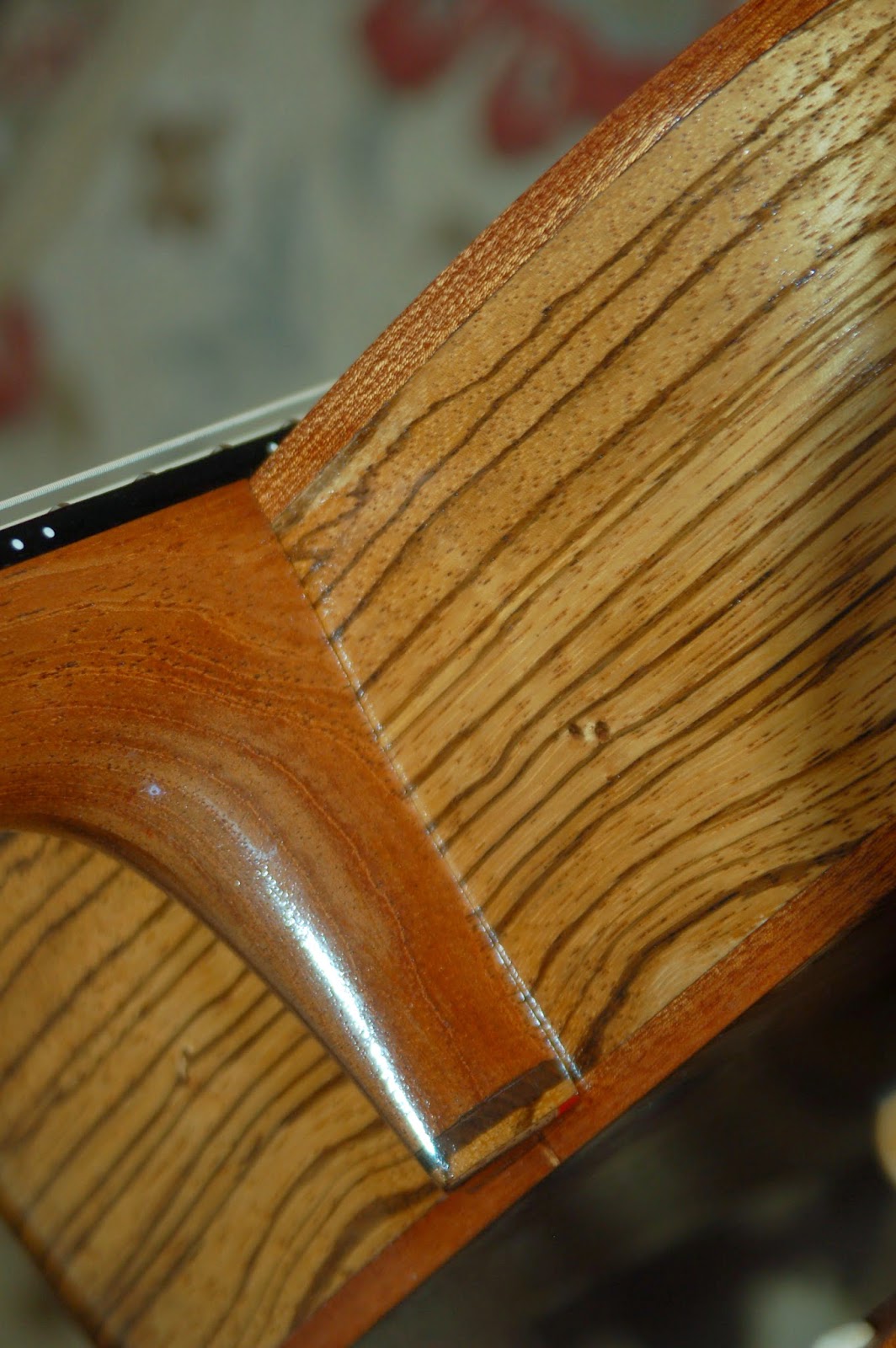'Francesca' has a lot of interesting characteristics, which I will attempt to explore, without boring you too much.
The mahogany neck is a 14-fret, one-piece, style with falute and 15-degree scarf joint headstock angle.
The overlay is a collection of hand-designed pieces of exotic wood formed into a collage which features a stylistic guitar design as the focal point. (The overlay and all inlays were described in a previous post, when I started the project. For details, please review that post.)
A Sitka spruce top sits atop highly figured bookmatched zebrawood sides, whiich were formed in the special side bender I created for the purpose, and which is featured in a previous post.
Handmade Sapele binding joins the top and back to the sides. I chose to make the wood binding, because it adds so much character to the overall build, and does not detract like a colored plastic binding.
 Grover closed-back tuning machines draw Elixir 10-47 strings across a hand-designed corian nut, and over an ebony fretboard with abalony position markers and medium/medium stainless frets. I decided on black for the tuners, because it does not detract from the design of the overlay like chrome would.
Grover closed-back tuning machines draw Elixir 10-47 strings across a hand-designed corian nut, and over an ebony fretboard with abalony position markers and medium/medium stainless frets. I decided on black for the tuners, because it does not detract from the design of the overlay like chrome would.The curvature of the fretboard tail matches the conture of the headstock, which in turn follows the shape of the rosewood bridge with handmade corian saddle and ebony pins with abalony inserts.
The special hand-designed rosette inlay of various exotic woods matches the tailpiece
inlay, which wraps around the tail of the body and into the back.
 The 'wing' design of the bridge follows the conture of the guitar body and further enhances the overall design, by carrying on the shape of the headstock and fretboard tail.
The 'wing' design of the bridge follows the conture of the guitar body and further enhances the overall design, by carrying on the shape of the headstock and fretboard tail. The saddle is handmade from corian and follows the curvature of the fretboard. Ebony pins with abalony inserts match the fretboard, and like the tuners, do not detract from the inlay designs.
Moving down to the tail of the body, you'll see another cubist inlay design made from small pieces of exotic wood. The shape is simple, but directs one's eye to the center of the guitar, where the similarity of rosette design can be seen.
 Dropping down on the back side, the overall design continues with more small pieces of exotic wood. In the center is an ebony strap button, which matches the bridge pins.
Dropping down on the back side, the overall design continues with more small pieces of exotic wood. In the center is an ebony strap button, which matches the bridge pins.Here, you can really notice the sapele binding and zebrawood sides.
Flippin over to the back of the guitar, you will get a visual of how the two separate bookmatched pieces of zebrawood were glued together to form one solid piece. To carry on the inlay theme, I chose to add two smaller collages, one to carry on the tailpiece design, and the other at the heel end of the back to match up with the small collage on the neck heel.
At first, I had the idea to create a wide inlay of assorted pieces, which would run the full length of the back, but that idea was soon scrapped when I saw how the wood grain offered its own subtle design to the center line of the back.
So, a smaller version of the top-heel design became the order of the day, for the tailend and for the area adjacent to the neck heel cap, which is made of three layers of wood - walnut, zebrawood and a collage of color.



When I first started in on the journey building acoustic guitars, I sought the advice and direction of a numbers of folks, who have been doing this for a long time.
And, the one thing that 'old timers stressed as the most important aspect of all is neck angle, with respect to the body, and how closely the neck fits to the body at the joint.
If the angle is wrong, the guitar will never play properly, and if the neck/body joint is wrong, the same is true.
I took the advice to heart and the fit is perfect. Thank you Pat and Dan for your guidance.
This shot of the back side of the guitar shows off the color and grain of the body, the subtlety of the inlay color, the neck volute, and the Grover tuners.

Inside the body and out of sight are some of the most important design elements.
I follow the pre-war Martin Guitar design for top and bottom braces, which I hand-formed from raw pieces Sitka spruce.
All top bracing is scalloped, and back braces are tapered.
Serrated mahogany liner around the inside edges of the sides serve as glue areas for attaching the top and back.
And, small spruce rib braces were hand formed to support and stabilize the sides.
A final 'thank you' goes to my friend David for encouraging me to step outside my comfort zone and to add more personal creativity to this creation.
I cannot wait to share with you the next build, which is on the bench waiting for me to get going.






No comments:
Post a Comment